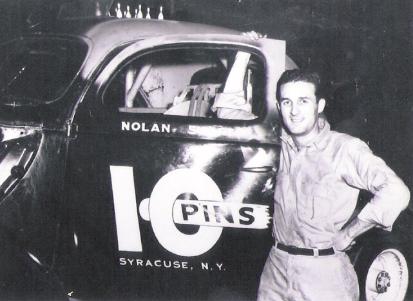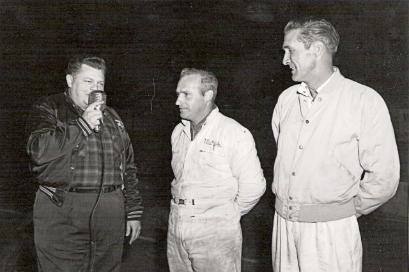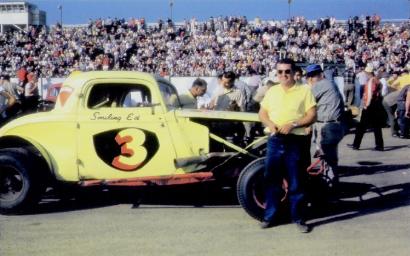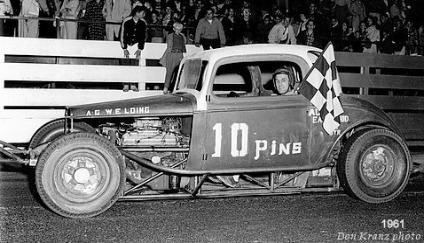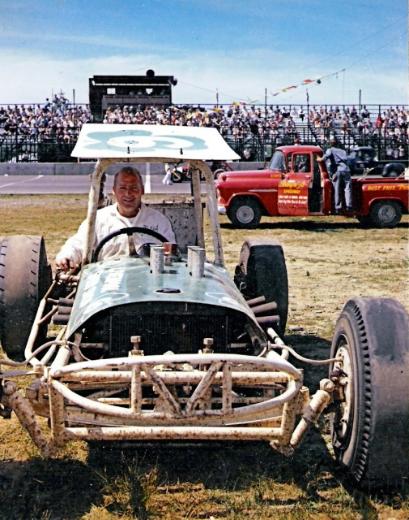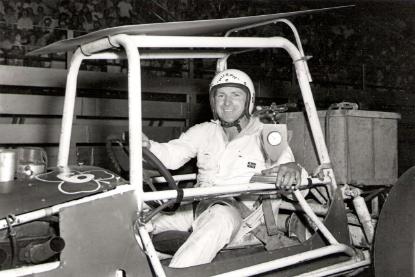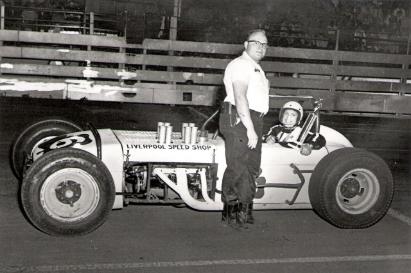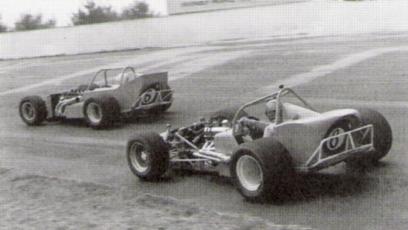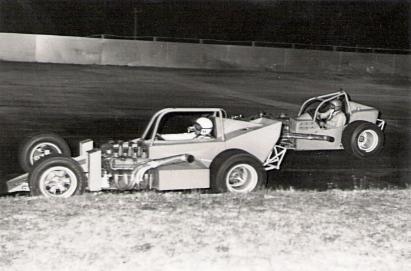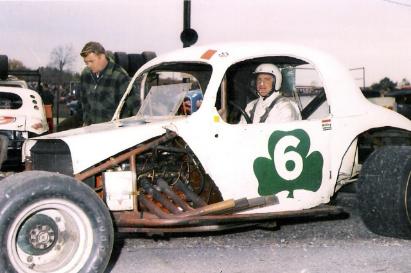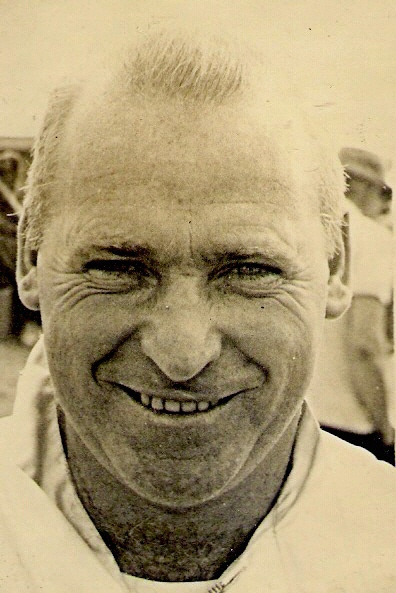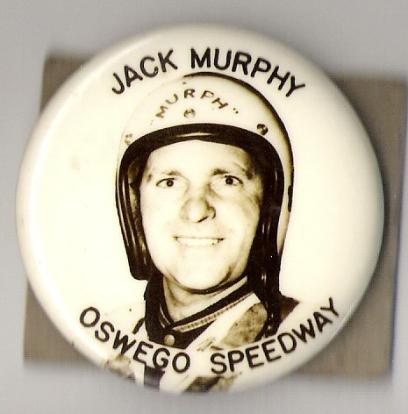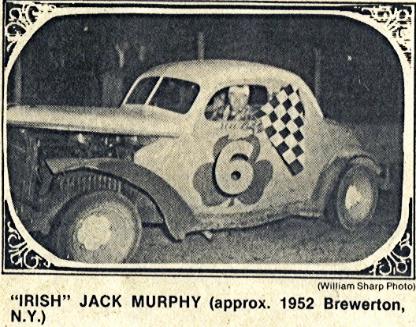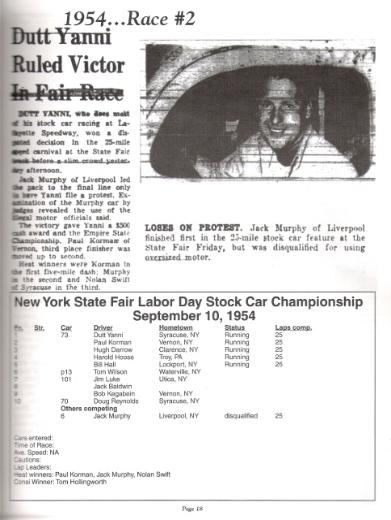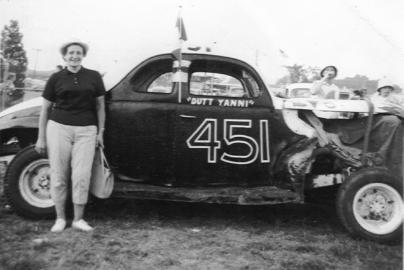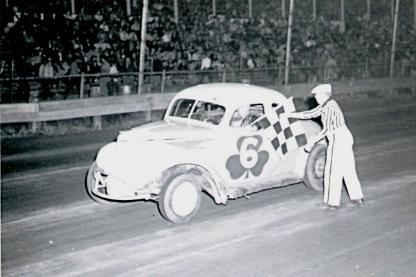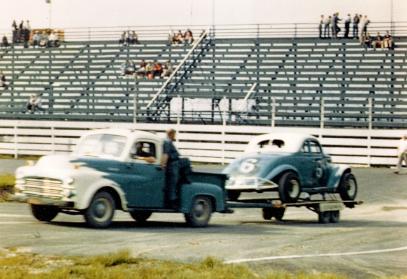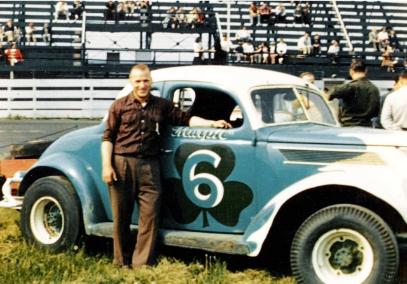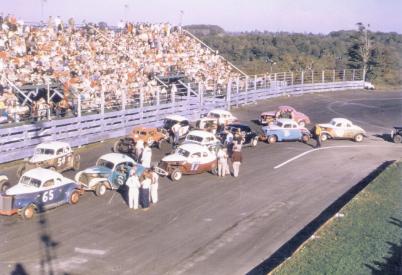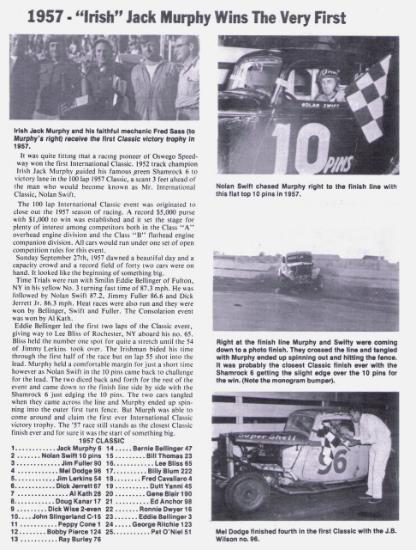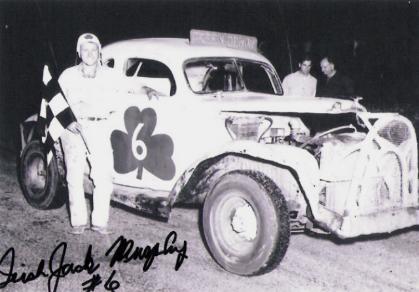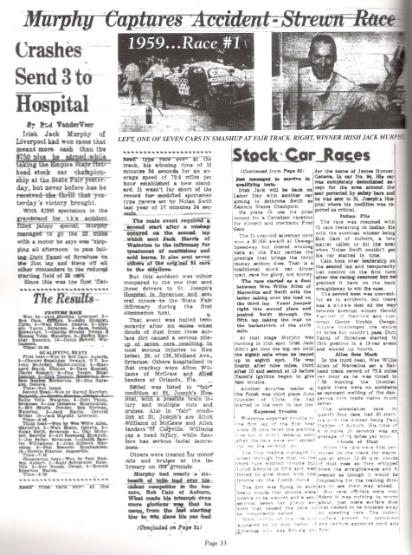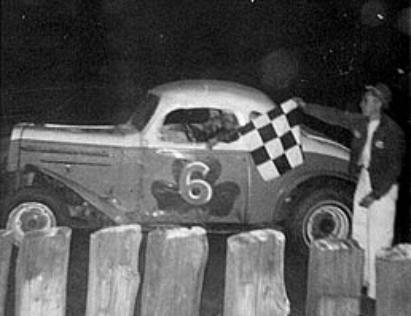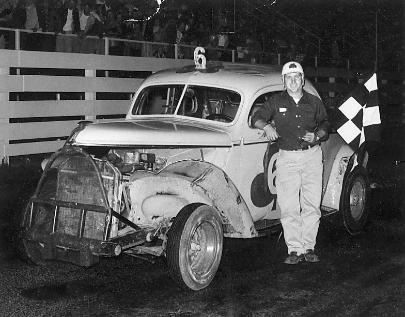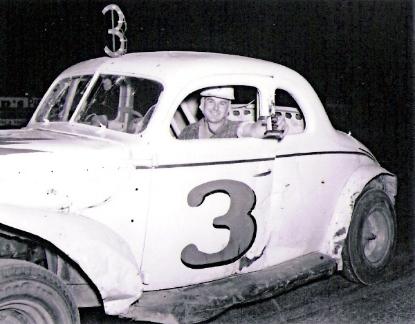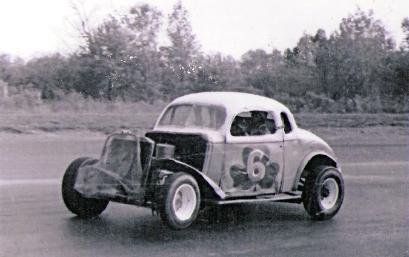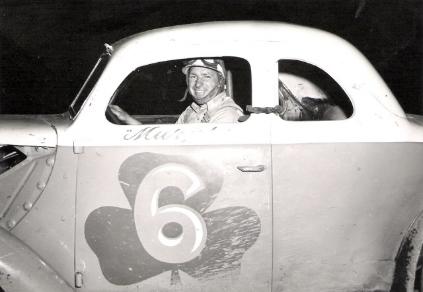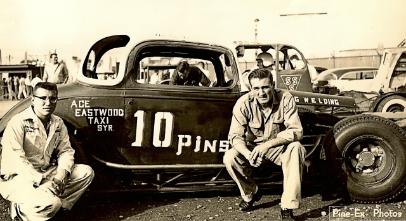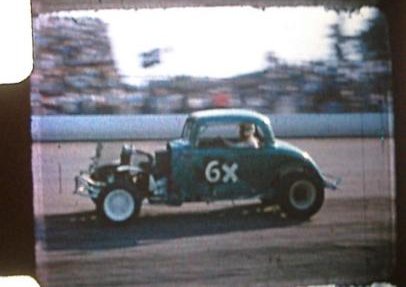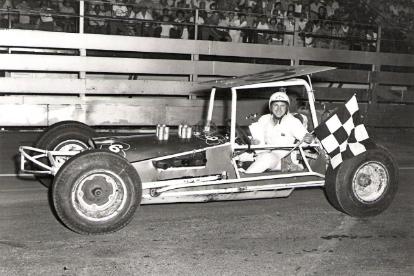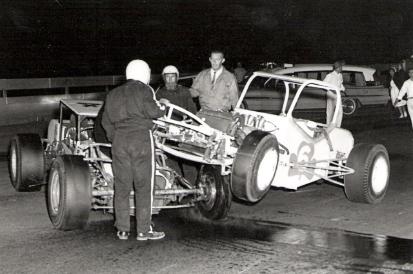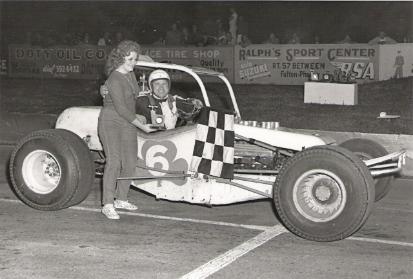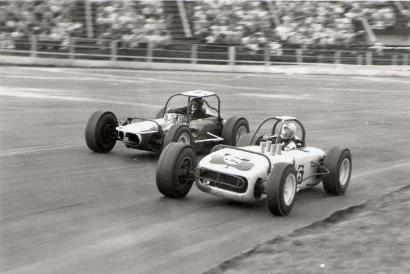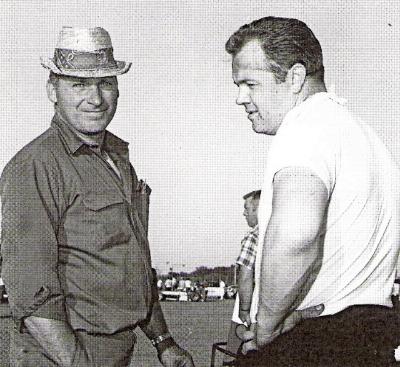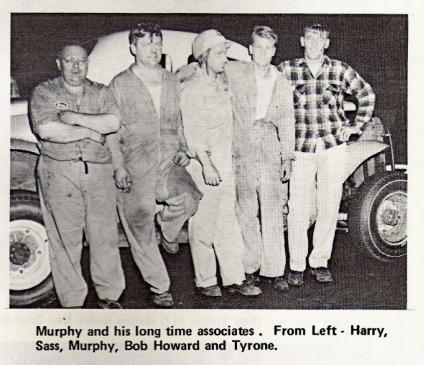~ Irish Jack Murphy ~
Article Published in Volume 45 #37, December 14, 2010 in the Gater Racing News
Although in general circumstances the term "Luck of the Irish" pertains to the tragedies and suffering of those of Irish descent, there were also less ironic examples in which 18th century Irish prospectors found gold and silver in great quantities. For the purposes of this article, we'll concentrate on a truly (at least most of the time) Lucky Irishman - that made the most of his opportunities..
'Irish' Jack Murphy was born December 22, 1927 in the town of Phoenix, NY and related that he was "Cheated out of Christmas". Allright, well if you're keeping score at home, bad luck =1. After his father passed at age 2, he went to visit his Aunt and Uncle on Cold Springs Road in Liverpool, NY and "I never went back home, I lived with them all my life." At Liverpool High School he played all three sports; as a center and guard in football, a forward in basketball and catcher in baseball.
"As soon as I was 18 I enlisted in the Navy" in 1946 and went to Great Lakes for bootcamp in the winter. I can personally attest to the brutal cold at Great Lakes... He was stationed at Pearl Harbor working as an electrician and later finished his tour at Norfolk - "Aoogh!, what a place!" I know about that port too... 'Sailors and dogs keep off the grass...' Upon return to NY Jack went to work in construction and assisted in building Electronic Parkway in Syracuse. He stayed in Heavy Equipment once that job was complete, ending up as a master mechanic for Covino Brothers Pipeline outfit. He also worked for other contractors and on Nine Mile Island as a mechanic later, as well as the Steam Station in Oswego. His second job was helping Fred Sass run a Speed Shop nights "After working construction, we did engine balancing and boring, it was Fred's garage.." And that's where the good luck comes into play. For me the definition of 'Good Luck' is where preparation and perspiration meets opportunity, Jack and Fred prepared mightily for opportunity in racing - and it paid off.
"I didn't have much to do on weekends when I got out of the Navy, a friend asked if I wanted to go to Brewerton to the races and I said no, I didn't want to go. 'Aww C’mon’ and so he talked me into it. So I went and boy, this looked like fun. Next day I went out and bought a '37 Ford coupe from a farmer for $25 and built it up. It was 1949 and the Stock Car Craze was sweeping across America, pushing the midgets and big cars aside. "I knew nothing about an engine, somebody says to me, 'Get a hold of Fred Sass', good mechanic. So I did, introduced myself to him and we started from there. He was a great man. Drank a little bit...." 'That first year at Brewerton we didn't do very well at first. We were just starting out. Of course I painted the car green which was taboo at the time, a number of them told me to either change the color or we'll run you off the track. I told a couple of them they'd have to catch me first, AHAHAHA! Had the Shamrock #6 from the start.
When
Oswego was built (1951) we went up
there with that same coupe. It was dirt
then, and rocks.. It was awful, knock
your windshield out every night. Of
course, the Turcott boys, they were
tough, they'd run without a
windshield. A lot of Vernon,
Adirondack and Watertown guys were
there, the Kotary's, Hendenberg a
little, Bobby Kegebein, there was a
bunch. The track was rough,
competition was good, not anybody
had a lot of money in their car. If
anyone had a couple hundred dollars
in their race car, they had a good car.
Tires, we'd just run smooth ones from
the junkyard, sometimes they didn't
work out too good, they'd blow out.
Then Wilk's started re-capping them,
then Hoosier, then we started running
new ones."
For 1952 Oswego was paved. "The
dust was so bad (in 1951) that it’d just
drift up into the grandstand onto
people, it was terrible. The next year
they paved it and that was a big
change. They called it the fastest half
mile in the east, but it wasn’t a half
mile. It was 100 or 200 ft. short of a
half mile. Now it’s been enlarged and
they couldn’t call it a half mile
anymore so they call it a 5/8’s
HAHHaHA.” That first year on the
Oswego asphalt, Irish Jack won his
first track championship against the
likes of “Nolan Swift, Bobby Fons out
of Rochester, Billy Rafter, most of the
guys from Brewerton, the Turcott
boys, Art Reynolds, Billy Blum, Bobby
Cameron, he got killed at Lancaster.
Some of the Canadians came down
too.” The Shamrock 6 team continued
with Flathead power through 1953
picking up wins at Oswego and
Brewerton. “I was probably one of the
first ones to go overhead, Ford put out
their first overhead in 1954” and the
team branched out to new tracks
such as the Monroe County
Fairground near Rochester, as well as
Lansdowne and Pine Crest near
Toronto.
Jack also tried the NYS Fair in 1954… “I won it three times and got protested once..” My friend Bill Marsh is along for this interview and he’s been quiet up to this point, but now he says “Yanni”. And Jack repeats “Yannniii”.. I’d swear they both must have watched episodes of Seinfeld and picked up on the disdained pronunciation of “Newman” because they’ve repeated it in spades.. “That’s when I had the overhead, when they first came out with the overhead, Ford trucks had two different sizes, 279 and 317, of course we were only allowed 300 cubic inches. (The NYS Fair allowed overheads at that time). I had a sponsor (Paul J. Spaulding & Associates) for $500.00, and the flathead was getting pretty tired so I told him I needed another block. So he went down to the Lincoln dealer on the Boulevard and they had a display engine set up, a Lincoln 317 and he bought it and brought it out and gave it to me. And of course, it was 17 inches too big. ‘No problem’ he says to me, they got paperwork for a 279, same engine. So we ran it, we had an awful time with it. Of course we had to adapt it to the transmission, I don’t recall how we did it but we did it. And it had hydraulic lifters in it which didn’ t work, we played with it and weren’t getting much out of it. Took the lifters apart and made them solid and finally got them to working.
They ran two races (at the Fair) that year, I blew up my flathead the first race so I had nothing to run the next one, so we dug that engine out. It was under the bench and Fred says ‘Boy, the cylinders are like funnels’ I told him ‘it’ s all I got and I’ve already paid for the registration.’ So he says, ‘I’ll put a set of rings in it and see what happens.’ So we did, and the longer I ran it at the Fair, the faster it got. So, Yanni protested me afterward and Jack Brandt checked it, ‘It’s OK’ Jack said. Yanni didn’t know. When I pulled the head off, he had this ¼” inch plate, he wiped it with a rag, that went down in the cylinder, when he checked it, it was ¼” short on stroke. And then Yanni checked it, he said ‘I protested it, I’ll check it.’ So he did and agreed it was legal. Now, right after my sponsor Spaulding gave me this engine, he went off on his own. He bought another engine just like it and had his own car that Billy Lang drove, the #53. And of course Billy Lang and Billy Best and Billy Wright – they all knew. So, Billy Wright jumps up on the fender and says ‘Check another cylinder!’ HA HAHAHAHA. Belly Wright did that, I coulda punched him. Well, I already had the trophy and the jacket, HAHAH but I didn’t have the $500.00, that’s all you got back then.. Brandt didn’t check another cylinder, Yanni did. After Billy says ‘check another cylinder’ now I gotta turn it over and get another cylinder on the bottom, and I’m turning it over, I’m so upset and mad, I didn’t think of it, to get out and back it up a little bit, but he checked it and ‘Oh, what’s this?’ All I had to do was turn it to the next cylinder, it went down, the plate was still in there but there was a gap, and that was the end of the Lincoln engine.” “The next year he (Yanni) won it with his flathead and I don’t know who protested it, and HE was over. I was stranding there just looking, he says ‘They’re re- conditioned rods, they get longer, right Jack?’ I said, ‘Can’t help you Dutt.’ So he got protested and disqualified, HAHAHAHAHAH” Jack continued to run the Ford overhead through 1955 and 1956 and enjoyed a lot of success along the way. “I took a year off from Oswego and ran Rochester and Dryden. Jackie Soper was the hot dog down there and of course everyone wanted to see him beat. And we put our wide tires on and couldn’t even get around the track. The tire salesman, he comes in and is laughing, he said ‘Let me make you a set of tires’, I said ok. Took old 820x15, capped and sifed them and I went down there and beat Jackie. I wouldn’t believe it but those skinny tires worked at Dryden.”
“Of course I ran Lafayette then too – OH GOD – you don’t want to go off the backstretch there, then you’d be way down there. Oh, that was a dustbowl! Then he’d take oil all over the whole track before the race, what a mess! Oh Jesus! There was a guy who had a nice racecar there once, he didn’t have much anything for floorboards, he was a mess..” Bill Marsh chimes in “Lafayette had real good apples..” “I won the Monroe County Championship one year and I don’t know what year it was (1956?). I’d run up there, of course that was Nascar, then I’d go back to Oswego. Next thing, here comes the notice in the mail, ‘you’ve been fined and lost points’. I paid that 3 or 4 times and I didn’t go back to Oswego that year. I said to Ed Otto ‘Geeze, you took the money, didn’t have to take the points too.’ Monroe County was a nice track.” Jack turns to Bill Marsh, “I’d be down a couple of days after I raced to your Dad’s (Harley Marsh). He’d ask ‘How’d you do?’ And I said, Well, I was leading the feature and all of a sudden it started getting hot and I lost it. He said ‘Let me fix those pistons for you.’ So finally, I let him and I couldn’t believe what it did. Didn’t slow down no more.” Bill relates ‘He didn’t like the cam ground piston, he liked them round with lots of clearance.” Jack agreed, “Yep, he was after me quite a while about that and he was right.” During this period it should be noted that many drivers started showing up with lights on the top of their cars, Nolan Swift had 10 miniature bowling pins that he would ‘light up’ when taking the lead. Similarly, Eddie Bellinger had a large #3 in lights and Jack added a #6 to the top of his car. “When Nolan put the 10 pins on his car and lit them up, I says my ambition is to make him turn those light off. HAHAHAH I finally did it at Rochester and boy when I passed Nolan, I hit the switch.”
Even after paying fines and loosing
Nascar points, the temptation to run
outlaw proved to great… “At Menands I
did try to run under an assumed
name. It was a 500 lap race on a ¼
mile track. We were allowed two cars
on a team. I was running Nascar at the
time and Lee Bliss was running
Oswego. He was running a flathead
and I was running the overhead Ford.
I had the fastest time trial so I went
out first and you ran as long as you
wanted then came in between two
cones on the back stretch and the
other car went out. They kept score by
car numbers, mine was 6 and Lee was
5, some kept track of team cars and
different numbers. Well, they had no
idea where anybody was, all they
knew was who was first, second and
third. And that was something to go
out there, you didn’t have the big
Championship rears then and man,
those little rears would get hot. You’d
pour grease in the rear every time you
came in. So, we win it and they said
we didn’t. You were allowed a
Sportsman and a Modified, I was the
Modified, Lee was the Sportsman, he
had the flathead. The drivers down
there interpreted it that
you had to have two Flatheads. So we
went to talk to the promoter, and they’
re going
back and forth so finally the racers
said ‘let’s take 1st, 2nd and 3rd and
we’ll split it.’ ‘No,’ we said, ‘we won it’
and we wanted our money. We told
the promoter, ‘it’s getting late and we’
ve got to work tomorrow so we’re going
to impound the purse and we’ll figure
it out next week. ‘No’ said the
promoter, ‘we can’t do that, so we’ll
pay 1st, 2nd and 3rd and figure the
rest out later.’ Well, they never did
figure it out, I talked to guys later and
they never got paid. I said to Lee,
‘Well, we got our money and the
trophy but we might have to fight our
way out of here… we got out but it was
brutal, 500 laps Christ!”
By the end of 1956, the writing was on
the wall for the Y-block, “I said to Fred,
we can’t beat them, we’re going to
have to join them. The ’55 Chevy didn’
t have any oil filter on them, in ’56
they did and in ’57 we went to
Chevrolet.”
It turned out to be a good move as
Jack returned to the Steel Palace in
1957 and at the end of the season
won the first 100 lap International
Classic with some bravado at the flag.
“It was a tight race, he (Nolan Swift)
was right on my tail and I said ‘I ain’t
never gonna let off until that first
turn, when the checkers flew I still
had my foot in it and around I went
into the cinder pile or something. He
never touched me, I just never let off
of it. It was my biggest win, $1000.00.”
And that was big money in 1957, no
wonder Jack kept his foot in it.
For 1958 Jack took up not only his
modified but a ‘B’ class Flathead car
as well at Oswego and points west. “I
remember at Spencer, Nolan Swift and
me were the only two running
Flatheads and the rest were all
running overheads. And when we got
up there they weren’t going to let us
run, we said, ‘we’re running flatheads
against your overheads.’ Dutch Hoag
and Lee Bliss replied, ‘Yeah, but we
know how those Flatheads run..’ well,
they finally let us run, Nolan won his
heat and I won mine and then Nolan
won the feature and I finished second
HAHAHAHAh!” Jack won the ‘B’ class
championship at Oswego that year
and also won Feature events in both
classes on the same night – the only
driver to date who has accomplished
that feat.
In 1959 Jack took to the road again and tried the ‘Track of Champions’. “That was terrible. Three times down there (Fonda) and three wrecked cars. I didn’t belong to the clique, Kenny Shoemaker asked me ‘Wanta join the club?’ – ‘No, I don’t want to join your club.’ The first time I went down there I’m leading the race ya know, lap after lap I don’t see nobody in the mirror so I started to let off a little bit, next thing I know I’m in the grandstand wall, Shoemaker got me WHACK! Promoter gave me, I think it was $100 maybe $50, ‘Fix the car and come back!’ ‘I’m gonna fix it.. yeah, three times was enough of that.” Jack had much better luck at the NYS Fair that year, “One of my wins at the Fairgrounds I borrowed a car, I didn’t even have a car for the Fairgrounds so I borrowed Sam Virgo’s car. Put our motor in it and got the win, that was number 23. I don’t remember if we put our number on it or not, that was a Flathead.” And that one stuck as there was no protest this time.. With the new decade came the winds of change at Oswego as the ‘cutdown’ era began. Invaders from the Midwest and New England started showing up at the Steel Palace in search of the huge purses being offered, and the game was changing rapidly. “Art Bennet, we couldn’t hold a candle to ‘em. So, most of us took our bodies off, they looked like $#!% out there you know, just a roll bar going around. Trying to get rid of some weight and everything ‘cause they’re so chopped up. We still had to use stock frames.”
And so the ‘birdcage’ car was born, which of course soon morphed into the ‘Super-Modified’ class as the owners quickly left the pre-war coupes behind and started adding their own ‘hand formed’ tin. Two of the innovators of this era were Nolan Swift and Billy Wright, who built a radical tube frame car with torsion bar suspension. “Well, he built the thing and he had it down to Jordon’s garage in the city, and I stopped down there one day and Nolan is there working on it. He said ‘What do you think of this?’ And I said ‘That’s pretty nice, but’ I says, ‘If I got anything to say about it, it’ll never turn a wheel.’ Nolan says ‘What? Why’ s that?’ I said, ‘You’ve got to have a stock frame.’ He says, ‘The rules say “It may be altered.” If I take this pair of pants and cut them off there making them into shorts, they’re the same pair of pants but they’re altered.’ HAHAHAHA. I think he did it, I’m not sure but he just took an old frame and bolted it on the side of it. Piece of channel on each side – there’s my stock frame. They wouldn’t let him run it the first time he took it up there, and he wouldn’t take it off the track. So they hooked a wrecker up to it and took it off. And finally, I think the next year (1961) they let him run it. Eddie Bellinger and a couple of them were really on them that first night though, they made him park it. ” And so began the Super-modified Revolution.
Jack joined suit and built his own super for competition, not limiting himself to just Oswego he also made the trek to Shangri-La in Owego, NY as well. “That was pretty good, nice track down there. I wrecked a car two or three weeks in a row with guys blowing their engines in front of me. Got gun-shy after a while, didn’t want to follow anyone.” He couldn’t have been that gun-shy as he won features both in 1963 and 1964 there, as well as the Super Track Championship in 1963. He obviously liked the supers, “After I had my own Super I bought Todd Gibson’s car (the Flintstone Flyer) and had two for a while. Ronnie Wallace drove Gibson’s car in the Classic, and I drove my own. Ronnie had gotten in quite a wreck the week or two before and he was pretty sore, pretty raw. And he’d had enough, he come in the pits, they pumped some fuel in it and pushed him back out. He said afterwards, ‘I kept trying to quit and they wouldn’t let me, they kept pushing me back out.’ HAHAHAHA!” “The competition was tough at that time. Bellinger and Swift, Todd Gibson, Barnhart, Shampine. Bellinger was never that same after he got banged up. I ran the supers through the 60’s but didn’t have as much success. I was working, running the Speedshop nights during the week and not working on the race car until Saturdays, you can’t do that. There was a lot of competition from those guys in Michigan too.” Jack still looked for any advantage though in the time that he did have.. “We tried a crossfire, ever hear one run? Couldn’t keep them together, they’d loosen all the bolts on the car and getting the wiring straight was something too…” Even though he wasn’t wining as much during the 60’s, he was still in demand as a driver and confidant as evidenced when Jim Shampine asked Jack to shake down his new ‘Wedge’ Super in 1969. He also drove Dave McCredy’s back up car at Langhorne a few times, capturing 6th spot in 1967 with, as Fred DeCarr recalled, ‘the gears in upside down.’ Of Langhorne he remembers, “I had a Studebaker I took down there once, it just weighed too much, I didn’t take enough junk out if it. Very nice, aerodynamic car, I qualified with it but didn’t have enough horsepower to carry around the extra weight.” “By 1970 I wasn’t running much. Fred (Sass) died in ’69 or ’70 and I put the last car together myself for the Fair, after he died that was pretty much it.”
Jack went out with a bang though.. Bill Marsh recalled “You finished it up at the track as I remember.” “Yep, I won the heat and I said ‘Holy $#!%’ I got fast time. Some guy come up and wanted to buy the car from me right then, before the feature. I said ‘You could have it right after, but I didn’t see him again.” It was just as well because after winning his third NYS Fair Championship (Yes, I’m counting 1954 as well..) Jack took the car to Langhorne again and knocked down another top 10 finishing 8th. “That was about the end of it, I drove the same car the next year (1971) for Dean Hubbs at the Fair, the year after I sold it to him and I couldn’t even go around the racetrack with it, terrible. He had wrecked it and then straightened it out with his dump truck and bulldozer, it was awful.” And so ended a 22 year career of racing full of highlights, a few disappointments and a lot of memories. I asked what his favorites were: “Probably winning the first classic. Also Dutch Hoag. Not a good memory, but when he saved Billy Blum’s life at Fulton. I was sitting in the grandstand right there looking right at ‘em. Billy hit that wall and turned on his roof and you could see a little flame about this big as he was losing gas going across the track, he was on the infield upside down, knocked out. And I said anyone could have put that fire out then if they’d snuffed it immediately. But, when it gets to that car, because the gas was just pouring out of it, it’s going to be a bomb, and boy, it was. The firemen, they were just standing, way the hell away from that car. Dutch was in that race, parks his car on the backstretch, ran over there, took the fire extinguisher away from the guy and went in the car. The fire was all around. Billy was a big guy ya know, and he unbuckled him and brought him out. Layed on the ground there, Dutch walked right to his car, drove it in the pits, put it on the trailer and went home. I could never say enough about that guy. One time in Langhorne, that track would mess up your windshield, you couldn’t see half the time, and I was already out of the race. I sat down there in the first turn, they were under caution, here he comes down, leading the race, on the pace lap and he’s standing on the running board outside the car, wiping his windshield off. I never saw anything like that. Dutch got back in it, got buckled up before the green flag.” He talked of his competitors: “No, I never got into fights. Got along well with everyone. Oh, I had some run in’s with Nolan. But, after we quit racing we started hunting together, went to Colorado. In fact the first trip he made me sign a piece of paper, I said ‘you’re $#1%%7#@ me’, he said, ‘No, I’m serious.’ So I signed the paper saying I wouldn’t shoot him. HAHAHAHAHA!!!”
On Jim Shampine:
“Everyone got along with Shampine.
When I bought Gibson’s car, he called
me up. Of course, Jimmy was easy to
pass at first, just come up on him and
no problem, he smartened up though.
And he was a great competitor, he
called me up and asked ‘Would you
mind if I came out and measured up
that car?’ I said ‘No, c’mon out.’ So he
and Okie come out and measured this
and measured that. He was quite a
driver, pretty tight with money… I
read in the paper where he’d won two
or three in a row up there (Rolling
Wheels) and I though ‘what the hell is
going on’ so I went to the race and I
saw what he was doing. He come down
the straightaway and come right tight
to the inside, let off and stay on the
bottom, the others were off high, he
drove it like asphalt..” Since we were
on the subject of driving style I asked
for a lap around Oswego: “First turn
right on the inside fence, I’ve
scrubbed a wheel on it many times.
Second turn you start to drift up. By
the fourth turn you got up there on
the bank and get that shot down the
front stretch. If the guy gives you
room, the second groove in turn one
isn’t bad.” Conversely at Syracuse:
“First thing I tell you is stay away from
that inside fence, and you don’t want
to get out in the marbles in three.” I
concur, the marbles in three will
guarantee a trip to the dry cleaners
will be necessary for your driving
suit… And that’s the style that won
Irish Jack 26 feature events at
Oswego, along with two track
championships at the track and three
Labor Day events at Syracuse. He won
races at many other tracks as well,
traveling to Shangri-La, Menands,
Lansdowne, Pine City, Brewerton,
Spencer, Lancaster, Lafayette,
Dryden, Montgomery County, Fonda
and Langhorne amongst others. Track
Championships at Montgomery
County and Shangri-La are also on his
resume but probably his greatest
achievement was the friendships and
respect that he earned, and that has
endured from his career in racing. Bill
Marsh put it best when he said, ‘Jack’
s a good $#!%, everybody always got
along with him.” He’s continued for 40
years as a good will ambassador for
the sport since retiring from the
cockpit as a fuel distributer and ISMA
officer. There’s no doubt he’s had
some good luck along the way, and
the sport too has been lucky to have
him. It was a pleasure talking with
Jack for this interview, and along with
Happy Birthday wishes, I also want to
thank him, as well as Bill Marsh for
the opportunity.
